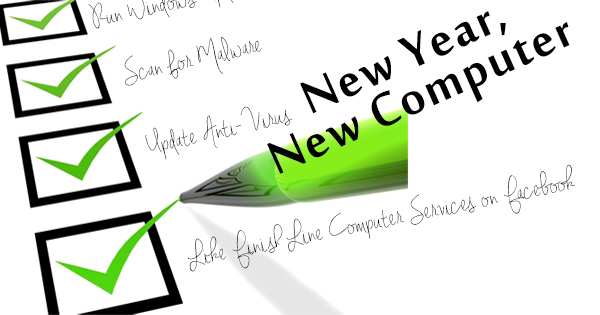
From all of us at Finish Line, (me) we (I) wish you a very happy and healthy 2016! The new year has started off with a bang, albeit a negative one in my family, but bones will heal and this too shall pass. Anyway, it isn’t often that one of our graphics details exactly what we’re going to talk about in a Blog post, but this one does. Some of you may have gotten a new computer for, or at the holidays, but if you weren’t so lucky, we’ll discuss how that old P.C. can be revived into acting like new. Also, these very same guidelines should be followed with a brand new computer in order to keep it performing at its best well into the future. With that said, let’s drop the ball on a new year of the Finish Line Blog!
Checkbox number one corresponds to “Run Windows Update”. If you’ve owned a computer with the Windows Operating System on it, from Windows 95 to Windows 10, you’re familiar with this phrase: “Updates are ready to be installed.” So, what exactly are these never-ending updates? First of all, we need to explain what an operating system actually is. Think of an operating system as a framework for a device (because tablets and phones need an operating system too). This framework allows the user to communicate with the device in order to achieve the desired result. The operating system manages the software and components installed on the computer to work efficiently and carry out the input as given by the user. As you can see, the operating system is very important! Microsoft generally supports an operating system for ten years after it’s released. Think back to 2006 and how much technology has changed in that time. The changes are staggering. Over that span, users will discover problems with their operating system, and new security vulnerabilities will emerge. To correct these errors or shortcomings, Microsoft will release Windows Updates, and in the case of a large volume of updates, a major release called a service pack. It’s critical to download and install these Updates for the safety of your computer (and your personal safety). It’s also important to keep “up-to-date” because many programs won’t run on a computer that isn’t.Occasionally a “bad” Update will be released causing a few headaches to the machine’s owner, but those are few and far between. To learn all that you ever wanted to know about Windows Updates, please read “Windows Update – Why Bother“.
Checkbox number two reminds us to “Scan for Malware”. What is malware you ask? In short, malware means malicious software. Malicious software is defined as any program designed to gain access to a computer or damage it without the consent or knowledge of the computer’s owner. The first three checkboxes really work in concert with each other to prevent malware: malware can sneak into a computer through one of the aforementioned security vulnerabilities in an operating system, or a computer without anti-virus protection. Many different types of malware exist, including spyware, adware, viruses, worms, ransomware, and scareware, and it’s impossible to use one program to stop and cleanup them all. It’s kind of like only needing to have one remote for your television – it just doesn’t work that way! So, what can we do to prevent malware for gaining access to our computer? First and foremost, make sure you’ve checked off #3 and updated your anti-virus software. Don’t have anti-virus software? I’ve had a lot of success with AVG Free and Avast Anti-Virus. Both options come in free or paid versions, though both have worked well for me for years and I haven’t felt the need to upgrade to the premium version. The programs are updated automatically, and regular scans can be scheduled to keep your computer humming. You’ll notice that these are anti-virus programs. It stands to reason that they’d be very good for preventing and eradicating viruses, but not for malware in general. I recommend Malwarebytes for that. There’s also a paid version of Malwarebytes. If you don’t want to think about updating or running the program on your computer, it’s well worth the investment of the paid version. If you don’t mind a little effort on your part with manual updates and scans, the free version will serve the purpose. Please read “What is Malware?” to wow your friends around the water cooler.
A new year offers the perfect opportunity to examine our lives and see what changes we’d like to make for the better. A computer is no different. It can always work better with a little emphasis on maintenance and care. Keep this checklist in mind in 2016 and beyond. The last checkbox is a little subliminal advertising on my part. Hey, you can’t blame a guy for trying!
